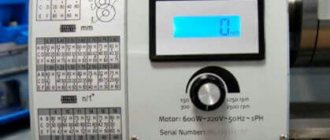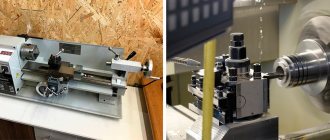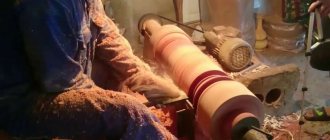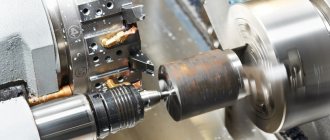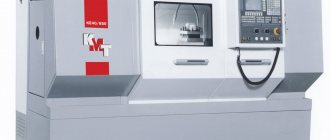Description and purpose
The benchtop lathe is designed for the production of single parts and small batches. It does not require much space and can be installed on a table or workbench. The space underneath is used to store tools and finished parts.
The TN-1M model represents a modernized version of the TN-1 screw-cutting lathe, popular in the early 80s of the last century. It can be used to process:
- steel;
- cast iron;
- alloys of non-ferrous parts;
- ebonite;
- tree;
- plastic.
The machine provides good finishing and high accuracy. When compared with floor-standing equipment, the TN-1M is not inferior to them in terms of productivity and cleanliness of processing.
Installing a movable tool holder turns the TN-1M machine into a universal unit with a large number of functions and the ability to sharpen external and internal cones with any slope.
The screw-cutting lathe TN-1M is intended for equipping student workshops in schools and vocational schools, as well as for installing them in multi-storey workshops and mobile workshops. The modernized model performs various turning operations:
- grooving of cylindrical, conical, spherical and shaped surfaces;
- boring of conical and cylindrical surfaces;
- countersinking;
- drilling;
- cutting external and internal grooves;
- trim;
- segment;
- cutting metric threads.
Processing accuracy class – N.
What metal operations can be performed
Homemade metal lathe with your own hands
Thanks to the fact that the human factor has been reduced to a minimum, metal operations have become much easier and result in less waste. It turns out this way because of the program that is embedded in the computer.
It is a kind of template by which the computer understands whether the part is ready or not. This section will talk about the operations that a CNC machine can perform on metal.
External and internal turning of parts
Everything is simple here, at least for the car. The installed workpiece, which in the future will become a part, is fixed on the machine. It can be secured manually or, if the appropriate equipment is installed automatically (most often the automatic option is used).
Afterwards, external turning of the part begins using either a laser or a blade that is installed on the machine. Gradually cutting off the excess, the workpiece takes the shape of the desired part. This is how external turning of parts is done on a CNC machine.
With the internal everything is about the same, only with changes. After installing the workpiece, the machine begins to drill, or as it is called differently, drill a hole at the base of the workpiece.
Once the hole is ready, the computer will compare it with the template that is written in the given program. If there are any flaws, he will analyze whether it can be corrected (as a rule, yes, because machines rarely make mistakes). Afterwards the workpiece is polished and the part is ready.
Longitudinal processing of the workpiece
Longitudinal processing is a method that is used for the manufacture of strips, strips, tapes. Depending on the program that is installed on the computer.
Such work on a CNC machine is carried out mainly using a laser, as this allows you to get rid of defects and speeds up the work process. After installing the workpiece, the numerical control on the machine will process it in accordance with the specified algorithm of actions. The laser portal is driven by stepper motors on which it is mounted.
Roughing and finishing
To begin with, what is this anyway? Roughing of metal consists of adjusting the part to the desired size by removing layers of metal.
Typically, in a CNC machine, this role is performed by the computer after the part has already been cut. Finishing comes next and consists of polishing the surface of the product. The machine performs all this according to given algorithms.
Adjusting the length of parts
The program that is given to the computer clearly states the dimensions of the part. The blanks are also given in suitable sizes. Before inserting a part, the machine adjusts and sets itself up for production.
After that, he begins to do the work, after which he compares the size with those given by the person. If there are no deviations, the part is ready. If there is, the CNC machine begins to grind the part, removing layers of metal and adjusting the length.
Making grooves, recesses and holes
Grooves and recesses are holes that are made into a part. Such holes can serve either to allow another part to fit into them, or for installation to some device. A CNC machine makes such holes using a laser, making high-precision cuts.
They can be rectangular, T-shaped, dovetail, shaped, through, open, closed and others. What shape the hole will be depends on the part and the program that the person has installed in the numerical control.
Inch and metric thread cutting
Almost everyone has seen this type of carving. It is used mainly so that one part can be screwed to another. The main parameters in the manufacture of such threads are pitch and size. In this case, a step means:
- outer diameter, measured between the top points of the threaded ridges located on opposite sides of the pipe;
- internal diameter as a value characterizing the distance from one lowest point of the cavity between the threaded ridges to another, also located on opposite sides of the pipe.
All parameters need to be entered into the machine’s computer, after which it will cut out an excellent and even thread using a laser.
Reference! In any case, the parameters for making threads on a product are entered by a person into the computer of the machine, and the latter, acting according to an algorithm, uses a laser to make an excellent thread.
Tabletop Machine Specifications
Main characteristics of the machine when working with metal workpieces:
- distance between centers – maximum shaft length 350 mm;
- turning diameter above the support – 90 mm;
- largest workpiece diameter 150 mm;
- maximum diameter fixed in the chuck 70 mm;
- maximum drilling diameter 6 mm.
The machine weighs 85 kg, operates from a regular household network of 220 V. Its power is 400 W.
Application area
Lathes are used for internal and external machining of cylindrical surfaces. Shafts, bushings, flanges, pulleys, couplings and other parts can be manufactured.
The workpiece is installed in a chuck, which rotates together with the spindle at specified speeds. The cutting tool makes a translational movement. Due to this, the workpiece acquires the desired shape and size.
Types of operations:
- End processing.
- Grinding the outer surface to a given diameter.
- Drilling and boring holes.
- Grooving.
- Cutting internal and external threads.
- Reaming and countersinking.
List of main components
The bed of the TN-1M lathe does not have stands; instead, there are low, wide legs. The main components are the same as for large floor-mounted screw-cutting lathes:
- front – spindle headstock;
- guitar;
- electric drive;
- caliper;
- movable and fixed tool holders;
- tailstock;
- The movable tool holder is mounted in the carriage and moves with the support.
Kinematic diagram
Main drive chain
Torque is transmitted to the spindle from the engine through a V-belt drive. The speed is changed by throwing the belt onto the desired pulley, including intermediate ones. The total rotation speed is 9. The switching table is located on the headstock housing.
Feed drive chain
From the spindle, rotation is transmitted to lead screws running along the bed. In the apron, the torque is converted into translational movement of the caliper. The first shaft is used for feeding during normal turning. A second shaft is used for cutting threads. Changing the direction of movement of the caliper is done by switching gears to different gears - one and a pair.
Kinematic chain of the turret
The turret head is moved manually by rotating the steering wheel connected by a shaft to a gear. Rack/. On which she rides, it is rigidly mounted on a sled. The drum has 6 screw grooves, with the help of which the drum with the tool disk is fixed.
Kinematic chain of the movable toolholder
The movable tool holder moves from the handwheel through the screw.
Fixed tool holder
The fixed tool holder moves mechanically - longitudinally along with the support. Manually moves in the transverse direction.
Tailstock kinematic chain
There is a handwheel at the end of the tailstock. When rotating it by hand. The quill moves in the tailstock housing.
What is needed for making
Metal lathe for home: types and technical characteristics
The ideal option when making a homemade lathe would be to use separate components from decommissioned equipment. If this is not possible, then you will have to make components and parts yourself.
Instead of a cast frame, a frame welded from steel profile pipes and angles is used. It goes without saying that a wooden frame is not an acceptable option in this case. The metal profile can provide the required rigidity and stability of the structure. In addition, with the help of even square and rectangular pipes, it is not at all difficult to adhere to the strict geometry of the frame. An uneven frame will not make it possible to correctly fix the centers, which will subsequently affect the quality of the work performed.
Low-power asynchronous motor - an excellent power unit for a homemade design
For the drive you will need a power unit. It is best to use a low-speed asynchronous electric motor. Unlike collector units, “asynchronous” units are practically not at risk of breakdown when the speed drops sharply.
In addition, you will have to select a drive belt (or several belts of different lengths). Don’t forget about the fasteners that will attach the individual units to the body. For a homemade lathe, nuts and bolts with a diameter of 8 and 10 mm with regular metric threads are suitable.
Parts machined from a steel bar and then hardened are used as slides, but the best option would be guides made from shock-absorbing struts or long shafts of industrial mechanisms. They have excellent geometry, and their surface is hardened in the factory.
The tailstock, like the spindle, is best used from decommissioned factory equipment
The tailstock can also be made from profile pipes and a thick metal sheet, but the quill is made from a hardened pointed bolt, several nuts with the same thread and a steering wheel made from a pulley from agricultural machinery. Using a homemade quill will require lubricating the contacting surfaces with lithol or grease every time you attach a part. A similar procedure will not be necessary with a factory-made rotating center, so if possible, it is better to buy this part.
The longitudinal and transverse feed screws can also be turned on a lathe or you can use a long threaded rod, which can be bought in construction hypermarkets.
For rotation units, you will need rolling bearings installed in the housing, and pulleys of various diameters mounted on the drive shaft will allow you to regulate the speed. These parts can be bought or ordered from a familiar turner.
Making a caliper will require stocking up on a steel plate with a thickness of at least 8mm. It can also be used for a tool holder.
Another component that cannot be made in a home-made environment is the spindle. You'll have to buy it. Mounting the spindle requires the manufacture of a shaft on which the driven pulleys will be mounted. The strength of this part must be impeccable, so it is best to use parts from discarded factory mechanisms.
In addition to the lathe, during the work you will need the following tools and equipment:
- welding machine;
- Bulgarian;
- grinding and emery machine;
- electric drill and set of metal drills;
- taps and dies for thread cutting;
- set of wrenches;
- caliper, metal ruler;
- marker.
All these tools and materials will allow you to make a full-fledged tabletop lathe. If you couldn’t get some parts, don’t despair - they can be replaced with something else for a while. Thus, a chuck from an electric drill can be used instead of a spindle if small workpieces need to be processed.
Main pros and cons
The TN-1M lathe does not require a special installation space. It can be placed on a table, workbench, or nearby bedside tables. The design of the frame dampens vibration. The equipment can even operate in a moving car or train.
The TN-1M model has several types of configuration with additional components and accessories. These include turrets, collet chucks, and various universal devices.
The machine consumes little energy, operates on 220 V, and fully replaces large units. Parts up to 350 mm long are not inferior in quality to those produced on large machines.
The movable tool holder ensures turning of cones with high angular accuracy over the entire length of the center-to-center distance along the outer surface and up to 200 mm inside.
When installing additional components, the machine can completely produce shafts with grooves, keyways, hexagonal and square elements.
The weight of the part is limited to 50 kg. Even if the dimensions are less than the maximum, it is impossible to install a more massive workpiece; the frame may be deformed.
The assembled machine weighs 85 kg, which allows you to install it on a table if necessary and remove it upon completion of work to free up space for other types of work.
About the cost and purchase of used devices
How to make a wood lathe with your own hands at home, drawings with dimensions?
Do not purchase the most expensive machine available on the market - most likely, there may be a model of equal quality, but cheaper, to solve your problems. However, you shouldn’t go to extremes and buy an advertised mini-machine that supposedly can do everything and at the same time has a suspiciously low price. It is best to approach the issue thoroughly: read all the reviews about the models, talk to sellers, read various sources on the topic and only then make a choice.
Another option is to buy used equipment. This will cost you less, but in order not to risk buying a faulty machine, ask the seller to present all the technical documentation for it before purchasing. We do not recommend that you purchase a device if the person does not have these documents. That way, if it breaks, you won't even be able to fix it because you won't know what part to order.
In addition, you need to check the quality of the mini-machine on site. Check how well the spindle rotates, how accurately the processing is carried out - the same as indicated in the data sheet or not. After a satisfactory inspection result, you can purchase the device.
Operating instructions for the unit, passport
The operating instructions are part of the documents accompanying the machine. It contains information:
- general information;
- contents of delivery;
- specifications;
- safe work rules;
- list of nodes;
- diagram of lubrication points - location of grease fittings;
- diagrams of all nodes;
- installation procedure; repair schedule and disassembly procedure;
- list and drawings of wearing parts.
The document contains information about the acceptance of the machine by employees of the technical control department, the date of manufacture and the manufacturer’s warranty.
The lathe machine passport can be downloaded for free from the link - Lathe machine passport TN-1 .
The TN-1M screw-cutting lathe with a turret head allows you to completely manufacture a part from one installation with high accuracy. Compact, it fits even on a wide windowsill.
Upgrade options
Modernization of the machine should go in several directions:
- increase power by installing a new generation electric motor;
- increase the number of working gears for a wide selection of speeds;
- increase rigidity in machine components;
- installation of mechanical and electrical protection for safer operation;
- adding auxiliary nodes.
Pulley belts
It is better to select belts for pulleys from poly V-belts from cars. Car belts have a large contact area (do not slip), small thickness (can work with smaller radii without overheating), without beating (no noise).
Emergency brake button
Braking is necessary in lathes. The easiest way is to modernize the electrical circuit. It is recommended to brake asynchronous motors by applying DC voltage to the motor terminals for a short time (1-2 sec.)
Installing the protective cover
A protective cover is mandatory to protect the pulleys and transmission belts on the spindle. It is recommended to make a protective casing with glass to protect the eyes from chips.
RCD and other protective devices
RCDs, fuses, thermal relays, circuit breakers, safety buttons must be installed on the lathe. The wires must be of the correct size. Securely fixed to the contact pads. Electrical protection means are much cheaper than your own life.
Lighting
Illuminating the cutting area with a table lamp with flexible fittings will help you work on the machine. The only note: it is better to use a reduced voltage to power the lamp. Industrial machines used a voltage of 36 V.
Collapsible base
The collapsible base is not recommended for a home lathe. The more massive the base of the machine, the less vibration and the higher the quality of the parts.
Using an emery or grinding wheel
The lathe can be equipped with an emery wheel and a grinding wheel to expand the capabilities of the lathe. When working on a lathe, an emery wheel is necessary for sharpening cutters.
What available tools can be used?
For homemade machines, in addition to parts from decommissioned lathes, some use an electric drill as an electric drive.
TN-1M Universal table-top screw-cutting lathe
Characteristics
| Accuracy class | N |
| The largest diameter of the workpiece installed above the bed, mm | 150 |
| The largest diameter of the workpiece processed above the support, mm | 90 |
| Height of centers above flat bed guides, mm | 75 |
| Maximum length of workpiece processed in centers (RMC), mm | 350 |
| The largest diameter of the workpiece processed in the chuck, mm | 70 |
| Maximum drilling diameter for steel, mm | 6 |
| Diameter of through hole in spindle, mm | 15 |
| Attaching the chuck to the spindle. Spindle end | M27x2 |
| Morse taper spindle | Morse 2 |
| Number of speed steps for direct spindle rotation | 9 |
| Spindle direct rotation frequency, rpm | 200, 271, 525, 650, 1000, 1200, 1700, 2800, 3200 |
| Number of spindle reverse rotation frequency steps | 9 |
| Spindle reverse rotation frequency, rpm | 200, 271, 525, 650, 1000, 1200, 1700, 2800, 3200 |
| Maximum torque on the spindle, Nm | 1,2 |
| Spindle braking | No |
| Handle lock | No |
| Maximum longitudinal movement of the caliper, mm | 350 |
| Longitudinal movement of the caliper by one dial division, mm | 0,05 |
| Maximum lateral movement of the caliper, mm | 90 |
| Transverse movement of the caliper by one division of the dial, mm | 0,05 |
| Number of stages of longitudinal feed of the caliper | 6 |
| Limits of longitudinal working feeds of the caliper, mm/rev | 0,05/ 0,75/0,1/ 0,125/0,150/ 0,175 |
| Limits of working cross feeds of the caliper, mm/rev | No |
| Number of metric threads to be cut | 18 |
| Limits of pitches of cut metric threads, mm | 0,2..2,5 |
| Limits of pitches of cut inch threads | No |
| Limits of pitches of cut modular threads | No |
| Limits of pitches of cut pitch threads | No |
| Cutter height, mm | 8 |
| Movement of the cutting slide by one division of the dial, mm | 0,05 |
| Angle of rotation of the cutting slide, degrees | No |
| Number of positions | 6 |
| Diameter of the base hole for tool holders, mm | 14 |
| Working stroke (manual movement), mm | 40 |
| Installation movement, mm | 50 |
| Morse taper quills | Morse 2 |
| Maximum movement of the quill, mm | 30 |
| Power supply parameters | 220 V, 50 Hz |
| Main drive electric motor, kW | 0,55 |
| Synchronous rotation speed of the main drive electric motor, rpm | 3000 |
| Machine dimensions (length width height), mm | 825 x 410 x 280 |
| Machine weight, kg | 80 |
TN-1M — Universal table lathe
Specifications:
Machines model TN-1m The machine is designed for various types of mechanical processing of metal, wood, and plastic products. The machine allows you to sharpen, drill and cut metric threads. The hollow spindle of the machine allows the use of bar material as a workpiece
Accuracy class: Diameter of the workpiece above the bed, mm 150 Diameter of the workpiece above the support, mm 90 Length of the workpiece, mm 350 Min spindle speed rpm: 200 Max spindle speed, rpm: 3200 Power, kW: 0.4 Replacement (analogs): CNC model: Machine weight, kg: 85 Dimensions (L_W_H), mm: 825_410_300 OKP: 381161 Manufacturer: Progress Michurinsky Plant, JSC
Machine characteristics
- lathes
- drilling machines
- boring machines
- grinding machines
- sharpening machines
- electrical machines
- gear cutting machines
- thread processing machines
- milling machines
- planing machines
- slotting machines
- broaching machines
- cutting machines
- other equipment
KPO characteristics
- mechanical presses
- hydraulic presses
- bending and straightening machines
- forging machines and rollers
- scissors
- automatic forging and pressing machines
- hammers
- equipment complexes based on forging and pressing machines
- automatic production lines
- mechanization and automation devices for forging and pressing equipment
- Various forging and pressing equipment
Characteristics of imported equipment
- Lathes
- Drilling machines
- Boring machines
- Grinding machines
- Sharpening machines
- Electroerosion machines
- Gear processing machines
- Milling machines
- Forging and pressing equipment
- Other equipment
- Pipe processing machines
- Band saws
- Machining centers
- Honing machines
Characteristics of Electrical Equipment
- High voltage devices (over 1000 V)
- Low voltage devices
- Powder metallurgy products
- Cable products
- Integrated control devices for electric drives. Electric drive
- Complete control, electrical energy distribution and protection devices for voltages up to 1000 V
- Medical equipment
- Pumping equipment (pumps, pumping units and installations)
- Air conditioning and ventilation equipment
- Semiconductor devices and converters based on them
- Instruments and automation equipment for general industrial purposes
- Lighting products
- Power capacitors and capacitor units
- Technological equipment
- Transformers (autotransformers). Complete transformer substations. Reactors
- Traction and crane electrical equipment
- Ultrasound equipment
- Chemical and physical current sources
- Electric cars
- Electrical insulating materials
- Electroceramic products, insulators
- Electric welding equipment
- Electrothermal equipment
- Electric coal products
Characteristics of pumping equipment
- Vacuum pumps
- Drainage, sand, slurry pumps
- Pumping stations, installations and motor pumps
- Drum pumps
- Water pumps
- Pumps for wells and wells
- Fuel pumps
- Chemical and aggressive media pumps
- Fecal pumps
- Other surface pumps
- Other submersible pumps
- Other self-priming and circulation pumps
- Other pumps
Steel and alloy grades
- Ferrous metals, steels, cast iron
- Non-ferrous metals and alloys
- Other steels and alloys
- Foreign analogues
Other equipment
News
02/10/19 — Added characteristics for refrigeration equipment
01.11.17 — Added characteristics for pumping equipment
02/16/17 — Updated specifications for the KA4537 press
Share information
Didn't find the specifications for the equipment you need on the portal? Send us a model of equipment that we do not have, and we will notify you as soon as we add the characteristics of this equipment to the site.
Lathe TN-1. Bargaining upon inspection.
Tabletop lathe drilling milling machine with 220 volt electric motor.
Reasonable bargaining is possible upon inspection.
pickup and takeout
The machines are in good working condition, an inspection has been carried out, I sell them with a check in operation. 3G71M surface grinding machine with horizontal spindle.
Powerful CNC system for laser/plasma cutting machines, with built-in THC height control function, with built-in autofocus. OS management
CNC CNC-11 TITANIUM pad is suitable for small-sized, mobile machines, laser/plasma/gas cutting machines. Briefly about the model: • k.
PRICE-QUALITY RATIO GUARANTEED! Our team of experts in our modernly equipped plant, cinder block mold press - press.
PRICE-QUALITY RATIO GUARANTEED! Our team of experts in our modernly equipped plant produces molds for cinder blocks.
Coolant 028872 Alfacut for plasma cutting systems.
A highly sensitive non-conveyor metal detector is designed for quality control and safety testing of geotextile materials. Quantity
Rack lattice container 05.T.042.20.000 produced. Designed for laying and storing clothes in it.
PRICE-QUALITY RATIO GUARANTEED! Our team of experts in our state-of-the-art factory produces pavement molds.
GIGANT
- Tabletop lathes
- Screw-cutting lathes
- Vertical lathes
- Turret lathes
- Vertical milling machines
- Horizontal milling machines
- Drilling and milling machines
- Milling machining centers
- CNC milling machines
- Widely versatile milling machines
- Special milling machines
- Bench Drilling Machines
- Vertical drilling machines
- Radial drilling machines
- Internal grinding machines
- Jig grinding machines
- Cylindrical grinding machines
- Surface grinding machines
- Grinding and sharpening machines
- Grinding and grinding machines
- Thread grinding machines
- Slise grinding machines
- Gear shaping machines
- Gear rounding machines
- Gear chamfering machines
- Gear honing machines
- Gear hobbing machines
- Gear shearing machines
- Gear grinding machines
- Slitting machines
- Horizontal boring machines
- Horizontal boring CNC milling machines
- Jig boring machines
- Balancing machines
- Slotting machines
- Sharpening machines
- Band saws
- Broaching machines
- Planing machines
- Thread processing machines
- Hand tool
- Guillotine shears, press shears Hydraulic guillotine shears
- Electromechanical guillotine shears
- Pneumatic guillotine shears
- Crank guillotine sheet shears
- Combined press shears
- Hydraulic press shears
- Crank presses
- Crank press brakes
- home
- Catalog
- About Us
- Clients
- Manufacturers
- News
- Contacts



